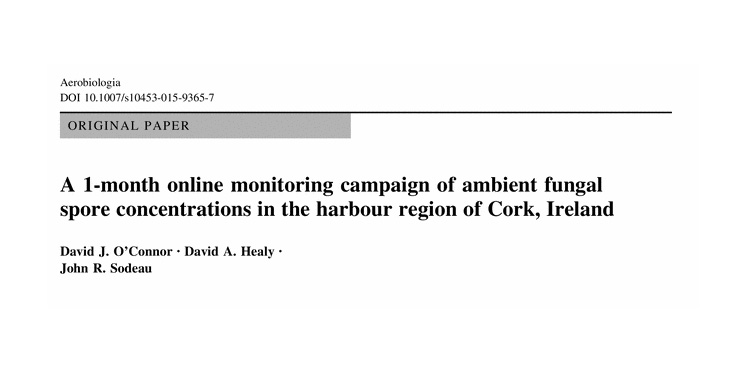In This Section
New Publication in Aerobiologia

Publication from O'Connor/Healy/Sodeau.
An atricle has been published in Aerobiologia based on work by Dr. David O'Connor.
Abstract
The airborne monitoring of bioaerosols has become a research area attracting significant scientific interest over the last few years because of potential impacts on human health. For example, so-called primary aerosol biological particles (PBAPs) such as pollen and fungal spores are known to induce allergic responses and therefore exacerbate reactions such as allergenic rhinitis (hay fever) and chronic obstructive pulmonary disease. Although impaction/optical microscopy has been used for many years to quantify airborne PBAPs, the use of fluorescence as an underpinning method to enable the development of online (“real-time”) instruments, such as the Waveband Integrated Bioaerosol Sensor (WIBS), is recent. In the current study, the conventional method of PBAPs sampling (automatic Hirst-type volumetric trap) was co-located with a WIBS-4 instrument at a campaign site in Cork, Ireland, close to its Harbour, for much of the month of July in 2010. The extensive data set thereby obtained represents important results to test the ability of the WIBS-4 approach to detect and quantify biological particles in the coarse to super-coarse size range (3–30 µm) at a location with semi-rural, semi-urban and coastal influences. Quantitative and qualitative comparisons were made between the different approaches. It is clear from the results obtained in this short field campaign performed in a relatively complex ambient air environment that the WIBS-4 instrument in low gain can provide very similar concentration patterns to those obtained by more traditional instrumentation used for the evaluation of fungal spore concentration levels. WIBS does, however, appear to overestimate particle concentrations in comparison with data obtained using the SporeWatch/optical microscopy approach. Interestingly, certain time periods in the campaign gave rise to contrasting fluorescence averages that correlated with the concentrations of certain fungal spore types monitored by the traditional impaction/optical microscopy approach. This phenomenon may be due to the differing biofluorophores available to differing spore types. The collection of real-time, early-warning signals of periods in which high releases of spores are occurring could prove to be beneficial in the construction of allergenic health warnings for the general public. This study should be considered as a proof of principle about the possibility of using light-induced fluorescence methods for fungal spore detection in ambient air.
Other Links:
- Full List of CRAC Publications
Centre for Research into Atmospheric Chemistry
Ionad Taighde Um Ceimice Atmaisféarach
Contact us
Lab B1, Kane Building, University College Cork, T12 YN60.
